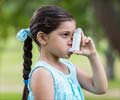Asthma risk in teenage years is associated with paracetamol use in infancy, says a study, which also quotes that the risk is stronger in children who have a particular genetic makeup.
- Children who are given paracetamol during their first two years of life may be more susceptible to develop asthma by the age of 18
- The risk of developing asthma gets stronger, if the children have a particular gene variant
- Further studies need to be done to establish a clear cause-effect relationship
Glutathione S-transferase (GST)
After its action in the body, paracetamol or acetaminophen gets broken down (detoxified) by several pathways in the liver to make it more soluble in order to get excreted.An intermediate formed in one of the breakdown pathways is toxic but is then quickly, irreversibly conjugated with the sulfhydryl groups of glutathione, an antioxidant to make it an inactive, non-toxic conjugate that will eventually be excreted by the kidneys.
Thus, glutathione is involved in mopping up the effects of toxins in the body and helps prevent damage to cells and inflammation. This occurs only when paracetamol is taken at the therapeutic or correct doses as prescribed.
In case of a paracetamol overdose, the levels of the toxic intermediate formed increases and outweigh the amount of available glutathione; this can lead to liver failure and kidney and is also detrimental to other organs like the lungs.
The metabolic isozymes involved in the conjugation of glutathione to the drugs are the glutathione S-transferases (GST).
Ms. Xin (Daisy) Dai, a nurse and PhD candidate at the Allergy and Lung Health Unit at the University of Melbourne, Australia explains the reason to conduct the following study. She says, "Paracetamol consumes glutathione, reducing the body's capacity to deal with toxic exposure. We hypothesized that people who did not have full GST enzyme activity because of common genetic variations or deletions may be more susceptible to adverse effects on the lungs from paracetamol use."
Study - Melbourne Atopy Cohort Study
Ms. Dai and her colleagues recruited 620 children to the study even before they were born. The children were chosen based on the fact of being potentially at high risk of developing an allergy-related disease - the children had a mother, father, or sibling with a self-reported allergic disease like asthma, eczema, hay fever or a severe food allergy. The team followed the children from birth to 18 years.Once the children reached 18 years of age, the team took a blood or saliva sample from them, to test for variants of the GST genes: GSTT1, GSTM1, and GSTP1 and for asthma. In addition, a spirometry test was taken where the amount of air inhaled and exhaled when breathing through a mouthpiece is measured.
- Children with one variant of the GSTP1 gene, the GSTP1 Ile/Ile variant (in which the amino acid Isoleucine (Ile) is inherited from both parents) but not the other types of GSTP1 had a higher risk (1.8 times) of developing asthma by the age of 18 years each time the number of days of paracetamol exposure was doubled when compared to children who were less exposed
- Increasing use of paracetamol in children who had a variant of GSTM1 was associated with a small but significant reduction in lung function, though this difference might not be clinically important
- Also, regardless of the variants of the GST genes the kids possess, the authors found a weak association between the use of paracetamol in the first two years of life and reduced lung function in adolescence
- All these results show that paracetamol use in infants with particular genetic profiles may have an adverse effect on their respiratory health and could be a possible cause of asthma
However, the association could be due to confounding factors – infants could have had lower respiratory tract infections caused by viruses, which were at the time treated with paracetamol and this could have caused asthma.
Hence, these findings would need to be confirmed by other studies, and the degree of adverse effect should be better understood before guidelines on paracetamol use are altered.
Reference:
- Eexpert reaction to conference abstract on paracetamol in infants and asthma in teenagers - (http://www.sciencemediacentre.org/expert-reaction-to-conference-abstract-on-paracetamol-in-infants-and-asthma-in-teenagers/)
Source-Medindia
















